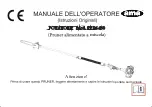
english 21
Setting into operation
Please read the safety instructions before setting the saw
bench into operation.
All protective and auxiliary devices must have been mount-
ed. The is ready for operation when it has been connectec
to the mains. NOTE: In accordance with valid product li-
ability laws, the manufacturer of this device shall not be
responsible for damage to and from this device which re-
sults from:
• Improper care
• Noncompliance with the Operating Instructions
• Repairs made by unauthorized persons
• The installation and use of any parts which are not origi-
nal replacement parts.
• Improper use and application
• Failure of the electrical system as a result of noncompli-
ance with the legal and applicable electrical directives
and VDE regulations 0100, DIN 57113/ VDE 0113
Sawblade height adjustment – Sawblade angle adjustment, Fig. H
• The height adjustment is made by the rotation of the
wheel on the front of the machine (1).
- Saw blade Ø 280 mm = height of cut from 0 to 90 mm
at 90 ° and 0 to 68 mm at 45 °
• For adjusting the sawblade angle setting pull out the
hand wheel on the right side of the machine (2)
- Tilting the blade from 90 ° to 45 °.
- Once the adjustment made, tighten the grip blocking (3).
Parallel guide, Fig. J, J1, J2
Fine-adjustmen
Fine adjustment is with the adjusting spindle (3) with the
eccentric lever (1) is blocked and the eccentric lever (2)
is open.
Stop rail
Position 1 (Fig. J1): For working with raised stop bar sur-
face. The dispayed cut width is on the black display scale
(1). (Higher stop bar surface symbol)
Position 2 (Fig. J2): For working with lowered stop bar sur-
face. The dispayed cut width is on the black display scale
(1). (Lower stop bar surface symbol)
Push-stick and push-grip
Push-stick: When cutting narrow workpieces lengthwise (i.e.
smaller than 120 mm), it isessential to use the push-stick.
Push-grip: When cutting small workpieces of special form,
it isessential to use the push-grip.
Mitre guide, Fig. G, Fig. G1
Set the mitre guide as the right or left of the sawblade.
The mitre guide can be directed angle of -45° to +45°.
Refer to graduate sector.
Locking fence, Fig. G2 (special accessory)
The locking fence mounted on the mitre guide is a perfect
complement to make length cuts with the mitre guide.
Changing the sawblades, Fig. F, Fig. F1, Fig. F2
IMPORTANT! Only use sharp, tear-free, unde-formed ‘‘origi-
nal scheppach sawblades’’.
Caution:
When changing the sawblade take out the mains plug!
1 Holding mandre
2 Left-handed hexagonale nut M24
• Take out the left-hand table inlay (Fig. F1)
• Insert the holding mandrel (1) into the saw spindle thr-
pough (Fig. F2) the bore in the right-hand side of the
table. For releasing or tightening up the hexagonal nut
M24 the saw spindle is locked with the holding man-
drel.
• Make note of the running direction of the sawblade.
Riving knife, Fig. F
Release the screw (1), insert and clamp in the riving knife.
The distance between the sawblade and the riving knife
must amount to no more than 8 mm and must be checked
each time the sawblade is changed and reset as necessary.
The riving knife tip must never be set lower than the height
of the base of the topmost sawtooth. A stting to max. 2 mm
under the topmost sawtooth tip is ideal.
The riving knife
is an irnportant safety device, which guides the workpiece
and prevents the cut pinching and the workpiece being
thrown backwards. Note the riving knife thicknessrefer to the
nurnbers starnped on the riving knife. The riving knife must
not be thinner than the sawblade body and not thicker than
its cutting joint width.
Attention! Close the protection cap
Risk of damage!
Maintenance
Always switch off the motor and disconnect the plug from the
power supply prior to any maintenance and cleaning work.
The following maintenance points should be checked on the
circular saw blench.
• Check the belt tension after approximately one operating
hour; retension if necessary. For this purpose open the up-
per side wall. By uniform adjustment of the fastening nuts
on the motor, adjust the necessary belt tension.
After this first initial adjustment, check the belt tension at
regular intervals.
• Occasionally, oil the roller chain and moving parts (height
and angle adjustment). Open the top right side wall.
• Ensure that the bench surface is always free of resin.
• The saw protection box must be cleared occasionally of
wood shavings and saw dust so that shavings do not jam
when ejected.
• The height and angular adjustment area may be reduced
by shaving deposits. Remove the left bench inlay and clean
the adjustment area.
Содержание 1901302901
Страница 2: ......
Страница 3: ...Fig A Fig A1 Fig B...
Страница 4: ...Fig C Fig C1 Fig C2 Fig C3 Fig C4 Fig C5...
Страница 5: ...Fig D Fig D1 Fig D2 Fig D3 Fig D4...
Страница 30: ...30 international Fig E Fig F Fig F1 Fig F2 Fig G Fif G2...
Страница 31: ...international 31 Fig G1 Fig H Fig J Fig J1 Fig J2 Fig 1...
Страница 32: ...32 international A...
Страница 33: ...international 33 B...
Страница 34: ...34 international C...
Страница 35: ...international 35 D...
Страница 36: ...E...
Страница 37: ...international 37...
















































